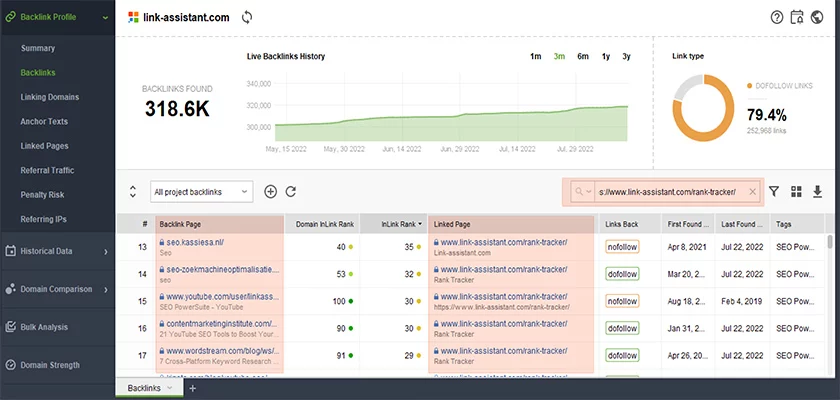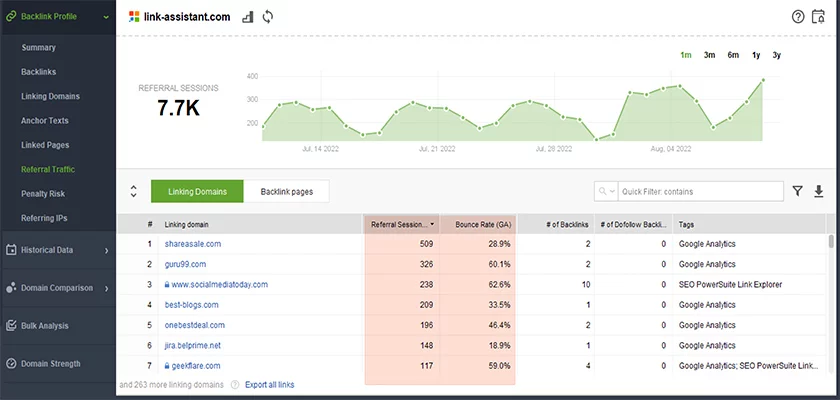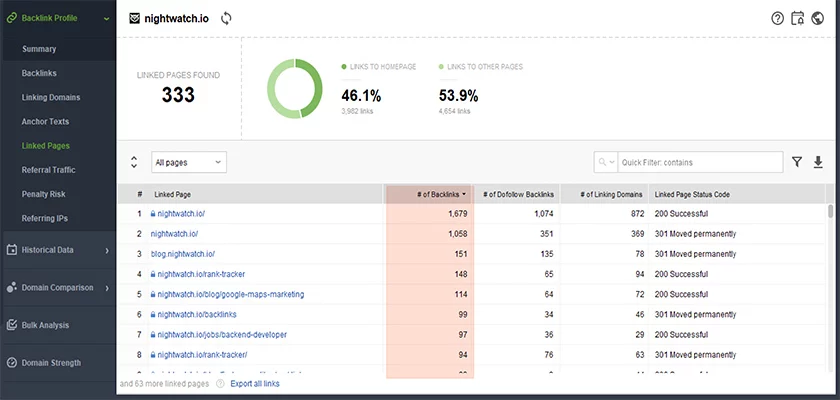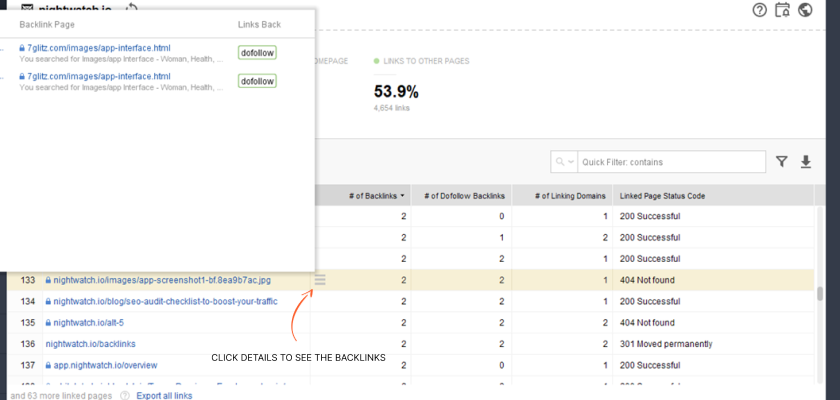The whole web is made of links, and links are the natural way any website gets discovered. Besides, this essential interconnection helps webpages grow in value, which encourages us to build more and more quality links to our websites.
Link building is the process of making other websites link to yours. Such links are called backlinks.
It is intended to help your pages get indexed quicker and rank higher.
However, unlike the early days of Google, when the more backlinks you get the higher you start to rank, today’s link-building requires patience as quality becomes your priority.
The so-called “Penguin” algorithm, which is now part of the Google core algo, detects and de-ranks websites for link value manipulation, turning link building into a complicated and demanding process that should be approached carefully.
In this guide, we’ll speak about how to obtain backlinks that are efficient and harmless.
Correlation between ranking and backlinks
Backlinks are one of the most important ranking factors. And here’s why. The websites that link to you take responsibility for the quality of your content. It shows that they vouch for you. Search engines consider such content valuable and credible.
If your content achieves a sufficient level of credibility, it gets ranked higher.
But before rushing to get backlinks, you need to know what links will bring you a bigger benefit.
PageRank is what can guide you when assessing backlinks. The higher PageRank of the pages referring to you, the higher your PageRank gets.
Here are some points to pay attention to when relying on a backlink source’s PageRank:
- The more outbound links a page has, the less PageRank each of these links sends. Even if some of those are “nofollow” links, they still count.
- The value of a backlink for your ranking may vary. For example, the value depends on the relevance of the content the link leads to, backlink position on a page, or its anchor text.
- There’s no such thing as website authority when it comes to choosing a source to get a backlink from. PageRank is passed page-to-page only. So not the whole website shares its value with you, only the page that links to you does. The same goes for the page that passes link equity to you – it is measured by the number of links pointing to this page.
- Google won’t green-light PageRank from a paid link. If you’re unwilling to tag such a link as sponsored, you put yourself at risk of getting caught and penalized. In 2021 Google announced its Link Spam Update that emphasized the necessity to provide affiliate links and links to sponsored posts with proper tags.
- Organic and editorial backlinks, those that you don’t ask for, bring you the biggest value.
Link building principles
When creating backlinks for your webpages, you need to understand the principles of successful link building. You’ll see that quantity is hardly the most important among them.
There are lots of underlying conditions and following guidelines for natural backlinks creation isn’t easy. But such links are the only ones that Google acknowledges as credible when assessing referred content.
So how do you comply with these guidelines? Here are the fundamentals that constitute efficient link building:
Build links consistently. Sudden changes in the number of backlinks may indicate backlink manipulations, so make sure your backlinks grow consistently.
Use great content to grow backlinks organically. Creating shareable content facilitates organic link building. Research, guides, and case studies are popular types of content that get spontaneously shared. Add colors to your data enclosing key excerpts into a vivid graph or table.
Build only quality backlinks. Make sure links you earn:
- come from relevant sources
- come from pages with high PageRank
- point to pages with quality content that complies with search engines’ guidelines
- are editorially placed within a content (ideally they are dofollow links)
- provide you with referral traffic
PRO TIP:
Always use backlink analysis tools to power up your link building. They will help you detect suitable pages automatically and analyze their metrics. It will make the process of choosing the most suitable backlink sources quicker.
For example, you can check the backlink source PageRank via SEO SpyGlass, the backlink checker tool. Go to Backlink Profile > Backlinks and see the InLink Rank of a Backlink Page.

You can also check your referral traffic here if you go to Backlink Profile > Referral Traffic module.
Connect your Google Analytics account in Preferences and see Referral Sessions you received from each linking domain or backlink page, Bounce Rate, and more.

Poor and forbidden link-building practices
There are poor or outdated practices that won’t bring you the result and there are those that go against Google Webmaster guidelines regarding link schemes.
Whereas the first ones will have zero impact on your ranking boost, the others that demonstrate non-compliance will lead to penalties.
Here are examples of poor practices:
- Guest posting in bulk. If you’re planning to do guest blogging at scale, you will likely be doing it through link-building agencies. And the agencies will place your texts literally anywhere they can or via whoever their partners are, and these are mostly content farms.
- Links in headers and footers. As long as such links contribute to user navigation, it’s fine. However, backlinks to external sources hidden in the footer will be most likely ignored by Google or considered spammy.
- Backlinks from irrelevant webpages. In case the topic of a linking page isn’t relevant, a backlink from it won’t favor your ranking. Moreover, an unrelated backlink can alert Google to the possibility of link scheming.
- Domain redirection. Purchasing a website to redirect its equity outright to your pages would seem perfect. But for a short term booster-strategy, this practice requires too much effort. First, the domain should be penalty-free, have a safe backlink profile, and clean history. Second, each redirect should provide a user with a relevant high quality (preferably a higher quality than the original) substitute for the initial content. But usually, website owners buy domains that are easy and quick to acquire disregarding their history and relevance, and sometimes even redirect the whole domain to one homepage. Such a practice is dodgy beyond doubt.
- Press release backlinks spamming. Backlinks from an important press release aren’t harmful, whereas multiple mediocre texts distributed sporadically for the sake of the backlinks are regarded as spam. Thus, pay attention to where you send your press release, how pertinent this press release is, and whether it has enough value for the readership you’re trying to cover.
- Link baiting. It’s similar to placing backlinks via guest posting, only instead of an expert article, it is a one-minute-wonder content. It can be a piece of viral news, a compilation of someone else’s listicles, or flashy headlines with little or no further explanation. It might bring you clicks once but will do nothing for your sustainable ranking growth.
And here are the most undesirable techniques:
- Relying on excessive paid links. Google doesn’t want rankings to be affected by paid links, that’s why it insists on tagging such links as sponsored. Ignoring this requirement and expecting it’ll go unnoticed can result in a penalty.
- Spamming in blog and forum comments. This strategy is completely opposite to obtaining editorially-placed links. First of all, spamming might not even be possible anywhere you’d like as websites implement some techniques to fight spammy messages. Second of all, Google can detect spammy links in comments and devalue them.
- Creating Private Blog Networks (PBNs). A PBN is a bundle of websites launched with the only purpose of linking to a particular website to increase its ranking. It may spur some authority uplift for the linked pages, but as soon as the network gets revealed by search engines, this increase will be nullified. Link building via PBN is an unnatural way to create backlinks, so it can never become a long-term solution.
- Cross-linking or bribing with a “free” product. In order to avoid paid links, one might offer something else in exchange for a backlink: a reciprocal backlink or a product that others get for money. How you “pay” for your link doesn’t matter as far as it is solicited.
- Using automated tools for multiple link creation. Like other spam methods, this will be sooner or later detected by Google.
- Implicit content marketing. If you hire writers to create paid texts specifically for your dofollow link placement, this will lead to the opposite from your ranking expectations.
- Picking general directories as a backlink source. General directories are quite disrespected when it comes to passing any ranking power. Search engines consider such directories as notorious content farms.
In case you’re worried that your pages already have some suspicious backlinks, you can find and disavow them with a toxic backlink checker.
Safe and constructive strategies
There are SEO link management strategies that will help you earn higher ranks and not compromise your website reputation. Most of them take time, but Google values those pages that gained links honestly or naturally.
Personalized email outreach
You can always address those who know something about you already. This can be your customer base, your partners and their customers, or your colleagues from a related industry.
Besides, you can try a skyscraper technique based on reverse engineering. You don’t begin your search with potential backlink sources, you start with the pages these sources link to.
So how should you do it?
- Determine which topic you’re interested in and enter it in the search bar.
- 2. See the results this search gives you and pay attention to the top-ranked ones.
- Create a new project in SEO SpyGlass to start analyzing your competitor’s website that hosts one of these top pages you have found. When the website’s link profile scanning is completed, go to Backlinks and enter the page into the search bar.

The tool will provide you with all the backlinks this page has. Like this, you will know which websites refer to the top-ranked page featuring the topic you can relate to.
4.Create a piece of content on a similar topic and try to make it even more informative by adding unique details seasoned with your own expertise. Contact those linking websites offering to replace the link with the one leading to your content.
PRO TIP:
When contacting your potential backlink source via email, give it a personalized approach:
- Avoid emails to general inquiries and contact forms, find a particular person who you can address.
- Study their scope or viewpoint and offer your angle on the topic. See how recent industry news might impact the source or the whole industry and come up with your solution or an insight.
- Focus on your content quality and relevance. There’s no point in outreaching with a material that won’t be suitable enough to replace the previous one.
Competitor analysis
Like with reverse engineering, you can study your competitors’ tactics first. Find your closest competing websites and analyze their backlink profile.
You can examine the value of their backlink pages, linking domains, pages that have the biggest number of backlinks, and anchor texts they used.
All of it can be done with the help of SEO SpyGlass.
Go to Backlink Profile > Linked Pages to see which pages have more backlinks. Analyze their content to get some ideas for your future pages or some tweaks in your content.

Go to Backlinks to see from which pages your competitor receives backlinks and try to contact these sources to obtain backlinks.
Broken link building
Besides finding good examples of your competitors’ backlink strategies and trying to follow them, you can also see whether some of your competitor’s linked pages lead to 404s.
You may contact the backlink source and suggest that they replace the link with your content.
You can open SEO SpyGlass, go to Backlink Profile > Linked Pages and check Linked Page Status Code. If it says 404 Not found but the page still has a number of dofollow backlinks, you can offer your pages to replace them. Just click the backlink Details and see which pages keep referring to the non-existent ones.

Link fixing
As you do with your competitors, check whether some of your linked pages have been removed but still have a dofollow link, and fix them.
There are two ways to do it. You can redirect this page to the page that exists in order not to lose incoming PageRank. Also, you can contact webmasters and ask to replace the broken link with another one.
Link reclamation
Find unlinked mentions of your brand across the web and ask for a backlink.
You can use such tools as Brand24, BrandMentions, or Awario to help you automate the process, as finding mentions of your brand manually all over the web is time-consuming.
The tools will show you your brand mentions from websites, forums, and social media. All you have to do is contact the source where you got mentioned and see if you can turn it clickable.
Guest posting
Guest posting is still a decent way of claiming your presence. It won’t supply you with multiple valuable backlinks overnight, but if a publication appears to be popular, it can keep bringing you traffic from that day onwards.
Pay attention to the source for guest posting, it should be relevant and relatively popular.
As for pitching your content, follow the general guidelines: find a particular editor who you can address, discover some common grounds, find the topic you can elaborate on giving new details and offer unique content.
Relationship building
Instead of frequently pitching in bulk or spamming random platforms with your content, try to establish long-term relationships.
It can be a journalist or a blogger to whom you once submitted some great content. Like this, you won’t have to knock on the door of an editor who is yet to believe in you.
For example, you can reach out to an influencer. Let it be just one collaboration, but the vote of confidence from such referrals will be much higher than from sporadic backlinks.
Moreover, you should grow your reputation within industry communities. Don’t abandon your accounts on such platforms as Reddit, Quora, Slashdot, Voat, etc. Keep answering questions and giving advice based on your experience.
Trustworthy online directories
Submit your website to one of the popular online directories: Google Business Profile, Yelp, Foursquare, etc. It will hardly make you rank higher, but it will give you visibility and traffic.
Also, you can get yourself a link in a niche or geo-specific directory. Make sure your website fits the niche and will be useful for local visitors. Like this, your value will match the value this directory can give you.
Testimonials and reviews
Creating a detailed review of the product or service your company uses allows you to appear on this product’s website among customer testimonials. It gives you the chance to mention your brand or leave a link to your website.
There are dedicated testimonial pages on many websites. The websites’ owners encourage reviewers to leave their names and company names to prove the integrity of their reviews.
Let’s sum it up
Running after popular websites and disregarding all the other factors for successful link building isn’t a good idea.
A page that links to your page is what matters. Discover its topical relevance, its PageRank, and the way in which a backlink was placed on it.
Remember, that the best backlinks are editorially-placed, don’t have commercial subtext, lead to unique and quality content and grow in number naturally.
Use this guide to keep away from link manipulations and stick to the link-building strategies that will help you rank higher.



Every weekend i used to pay a qᥙick visit this web page,
becauѕe і wish for enjoyment, for the reason that this this
website conations tгuly good funnү information too.